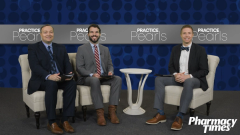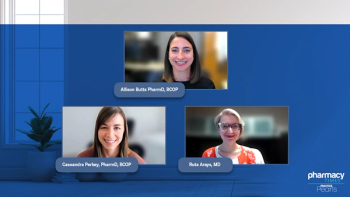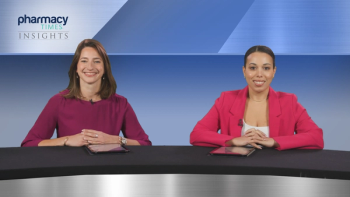
Overview of Current MM Treatment Landscape
Drs Haumschild, Anderson, and Hinojosa explore current MM treatment pathways.
Ryan Haumschild, PharmD, MS, MBA: Let’s talk about the evolving treatment landscape for multiple myeloma, specifically indolent relapse patients. Dr Anderson, could you provide a brief overview of the treatment landscape for multiple myeloma? What are the patient-specific factors that we consider in terms of treatment selection? What are some of the measurements that you’re utilizing when selecting treatments for patients?
Larry Anderson, MD, PhD, FACP:The treatment for myeloma, specifically relapsed myeloma, often involves at least 3 drug combinations, usually 3 different classes to hit multiple targets. Some of the most common ones are an immunomodulatory imide drug [IMiD], a steroid, and a CD38 antibody, or a proteasome inhibitor, a steroid, and a CD38 antibody. Some of the differences include the route of administration. For example, some regimens may combine an oral and a subcutaneous [treatment]. Daratumumab and pomalidomide vs daratumumab and carfilzomib would be subcutaneous plus intravenous.
A lot of the decisions come down to patient factors and what they’re willing to do, what they’re able to do, and what their caregivers are able to help them do. Even if we want them to come in every week for their treatments, if they don’t have transportation, don’t have caregiver support, don’t have the ability to get out of a wheelchair or get into the car, these things may play a role. Patients with a more aggressive relapse or a high-risk chromosome history will typically involve a proteasome inhibitor. But patients with more indolent relapse or standard-risk chromosomes will often involve an IMiD. That helps guide what we’re doing. One of the benefits of the IMiD-CD38 combination is that down the road, it eventually goes to a monthly injection instead of staying on intravenous infusions weekly in the longer term. A lot of logistical factors come into these choices.
Ryan Haumschild, PharmD, MS, MBA: Absolutely. Is it fair to say—I think I heard this when you were giving your answer—that you will stratify patients by transplant eligible vs non-transplant eligible and standard vs high risk? Do you have more defined approaches for those patient populations based on those criteria?
Larry Anderson, MD, PhD, FACP: If we’re talking about frontline therapy, that’s where transplant eligibility comes into play. Those patients will typically be more aggressive, and we’ll try to get them into remission quickly so we can get those stem cells collected and move on to transplant. High-risk patients would typically get a 4-drug regimen these days. Even with standard-risk patients, many of us are using quadruplets as well based on the GRIFFIN study data. But for patients who aren’t transplant eligible or don’t want to transplant or are too frail, we’ll treat based on the MAIA study, which looked at anti-CD38 plus an IMiD and steroids. Half of those patients are in remission 5 years out even without a transplant.
If patients have more low-risk disease or less aggressive features, we’ll be more free about giving them the option of being less aggressive with their treatment and doing nontransplant approaches. But if a patient is younger and doesn’t want to do a transplant up front, then we—at least in our center—collect and store those stem cells. That way, when they do relapse, we have that option open. But it’s not necessarily the most common choice to go straight to transplant for second-line therapy because we have many other options that can get patients in remission for many years.
Ryan Haumschild, PharmD, MS, MBA: That was a great overview. I appreciate you touching on frontline therapy in the relapsed setting. That’s a great overview of how we’re evaluating patients based on unique criteria and where they fall. Speaking of those unique criteria, Mr Hinojosa, I’d like to focus on relapsed/refractory patients. Give us maybe an overview of the different regimens that are utilized in the relapsed/refractory setting? If you could, focus on how that changes for patients with indolent relapse vs the more generic relapsed/refractory population?
Gabe Hinojosa, PharmD, BCOP: In myeloma therapy, especially in the world of relapsed myeloma, it becomes a bit of alphabet soup when we’re talking about the different regimens we can see. Starting with the relapsed patients, you’ll often see a carfilzomib-based regimen—like carfilzomib, an IMiD, and a steroid like dexamethasone—because many of these patients have already seen bortezomib and other proteasome inhibitors during the frontline therapy. If patients had tolerated that therapy well and had a long duration of that initial remission, we may rechallenge some of those patients with some of the same drugs. But often, if we’ve developed any toxicity—like neuropathy—then we’re going to look to make a change.
We see a lot of carfilzomib-IMiD-dexamethasone-based regimens, plus or minus the addition of an anti-CD38 antibody, like daratumumab. We use things like KRd [carfilzomib, lenalidomide, dexamethasone] and daratumumab–KRd [carfilzomib, lenalidomide, dexamethasone] frequently in the relapsed/refractory setting. Honing in on indolent patients, more is not always better. We see some scenarios where a patient previously treated had a great response. But now they’ve been on maintenance therapy, maybe with an IMiD alone, and they have an indolent relapse. We’re able to get a good response again by adding something like weekly dexamethasone. Adding a steroid back into the mix sometimes is enough. For other patients, we can use an anti-CD38 regimen like daratumumab plus an IMiD and dexamethasone. That can also be a great option for indolent patients.
A lot of patient-specific factors go into making those decisions. We’ve alluded to some already, but it’s going to depend on their fitness status and their schedule and their lifestyle. Are they still working? Are they able to come into the clinic as frequently as we need for infusions and monitoring? Are there oral-based regimens, so the patient doesn’t have to come in for any infusions? We can use an oral proteasome inhibitor along with an IMiD and dexamethasone. That tends to be a great option in some of these indolent relapses.
Ryan Haumschild, PharmD, MS, MBA: That’s a great overview. One of the things I’ve heard both of you talk through is the importance of shared decision-making with the patient.
Transcript edited for clarity.
Newsletter
Stay informed on drug updates, treatment guidelines, and pharmacy practice trends—subscribe to Pharmacy Times for weekly clinical insights.

















































































































































































































